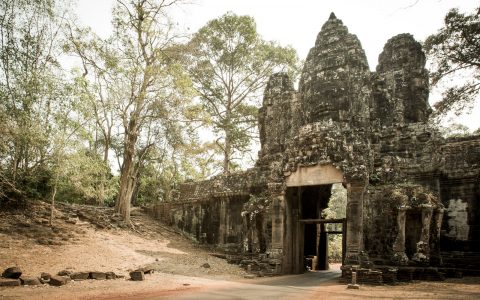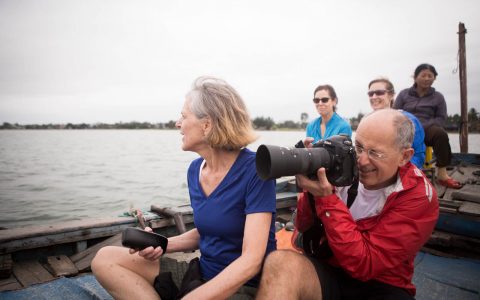The Zen of Guiding, Part I
![]() A lot of people ask me what I’ve learned—what skills and lessons I’ve accrued—in my 10 years on the road, living internationally. There are a few simple skills it took a number of years for me to realize as a guide, which can create a wonderful trip out of nothing.
A lot of people ask me what I’ve learned—what skills and lessons I’ve accrued—in my 10 years on the road, living internationally. There are a few simple skills it took a number of years for me to realize as a guide, which can create a wonderful trip out of nothing.
Not only that, but once these skills are honed and mastered, they can change your life. It is the Zen of Guiding, the art of constantly looking at the world as if you’re designing a once-in-a-lifetime trip, of living life as if it were once in a lifetime—which, of course, it is. These skills, much like the Tao Te Ching, or the sayings of Confucius, are simple in form but deep in value. They are as follows.
Love your taxi drivers.
George Butterfield said to me once that guiding was not a job but a lifestyle. Now, whether he was just making conversation or saying something from the heart doesn’t matter (and anyone who knows George knows it was most definitely the latter), it stuck with me and I focused on it as I was researching in the far-off corners of the globe.
Taxi drivers are a sorted lot; they can range from locals who know their city intimately to non-locals who just needed a job. Thomas Friedman references an accountant/taxi driver he had in India in his book The World is Flat. They are the vaudevillians of the transportation world, varied in skill and interests, and often entertaining. When I started researching routes on the Silk Road in northwest China, I was told by a friend that topographic maps at the time were illegal in the eyes of the Chinese government, and hard to find. Google Earth had even been manipulated to show highways disappear into the dessert, and my job was to learn rural routes in the oases in a matter of weeks, without maps or the internet, so I turned to the folks who know the roads best: taxi drivers.
A Picture is Worth (at least) 1,000 Words.

There was a learning curve required to figure out how to explain to a Uighur taxi driver in Kashgar that I did not want to take the highway nor the most direct route, but that I would be looking for small, quiet country roads for my friends to bicycle on for their vacation. After a few attempts to explain this, I stumbled upon a picture in one of our brochures of a guide in Burgundy standing in front of a van with a wonderful quiet country road in the back ground. I understood a picture is well worth a lot more words than I knew in Uighur, and started passing around copies of this picture all over the developing world to explain the idea of what I was looking for.
After a few trips to this region I would use the same driver each time to further our relationship and to further explore the sort of routes I wanted, in hopes that one day he would come to me with a list of roads he thought I should look. It worked. On my third trip to Kashgar, Adil (the driver) approached me in the market the day of my arrival, excited to show me his hand-drawn map and something new in his car. We walked through the market to the parking lot, where his Toyota HiAce van was parked, and there in the middle consol of the van was a shrine dedicated to the picture I had given him—a full-on shrine with flowers, offerings, candles, the works. Not only was I able to find the routes I needed, but was able to create a demi-god.
If you are ever in Kashgar, ask where you can find the “Lewis Evans” shrine.
Stay tuned for The Zen of Guiding, Part II, to learn all about the next essential skill I learned on the road.
MORE FROM Asia-Pacific + China

Biking in Cambodia with B&R Expert Guide Fin
Cambodia
The Slow Fund: Rice Production with Ozuchi Village
Japan
Take a Virtual Ride on the Hai Van Pass in Vietnam
Vietnam
How Three Cambodian Hotels Are Joining Forces to Feed Their Communities
Cambodia
Meet Fin—B&R’s Expert Guide in Cambodia
Cambodia
An Insider’s Eye on Vietnam: What to See and What to Skip, According to our Vietnam Expert
Vietnam
Photo Essay: Exulting in Mongolia’s Eternal Blue Sky
Mongolia
The Best Times of Year to Travel to Asia
Vietnam
Chris Litt: On Mongolia and the Desire to Disconnect
Mongolia
Top 6 Multi-Day Walks in Australia
Australia
The 8 Best Restaurants in Auckland
New Zealand
The 5 Best Restaurants in Wellington
New Zealand
8 Reasons Why You Need to Take an Australian Adventure
Australia
Cultural Quirks About Bhutan That Will Blow Your Mind
Bhutan
5 Things to Know Before You Go to Japan
Japan
8 Favourite Restaurants to Eat in Queenstown
New Zealand
10 Must-Try Australian Wines
Australia
Where to Eat in Hong Kong: 7 Best Restaurants
China
A Kiwi’s Guide to Enjoying New Zealand
New Zealand


